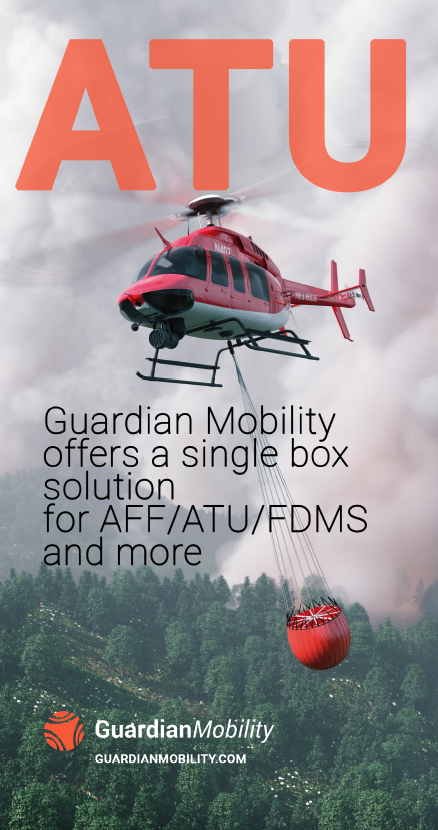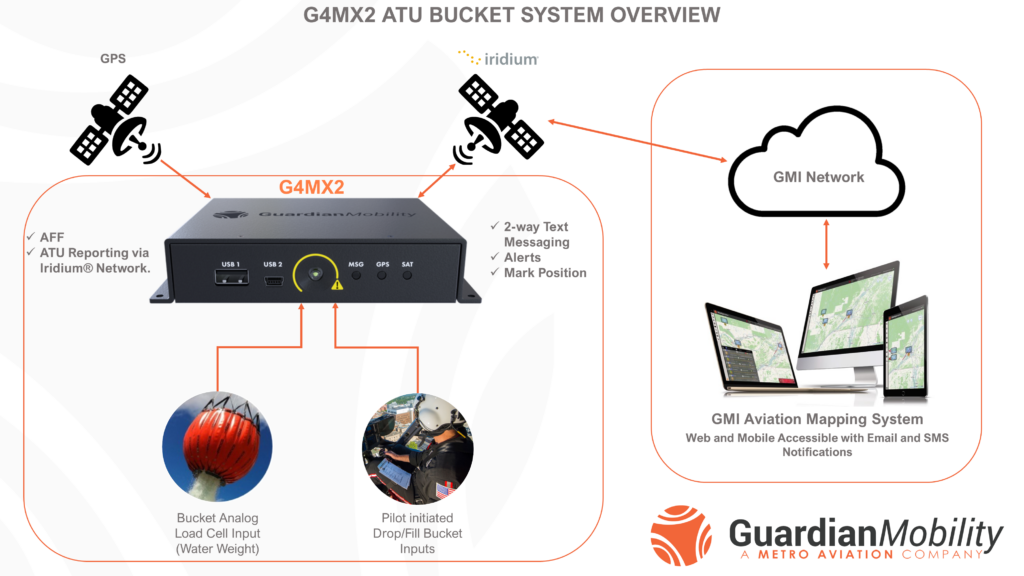Keeping up to date and understanding the new proposed contract changes may be challenging and daunting for operators. This article aims to simplify some of the recently proposed changes to the upcoming 2022 aerial firefighting helicopter (AFF) support service contracts with the United States Department of Agriculture (USDA) and the United States Forest Service (USFS). Draft contracts have been made available for feedback. The proposed changes introduce several new service and equipment requirements for aerial firefighting helicopter support services.
Some of the main changes to these contracts include equipment requirements for Additional Telemetry Units (ATU) and Flight Data Monitoring (FDM) systems. Operators have expressed that some of these changes will be challenging in terms of overcoming financial and logistical obstacles. While the final contracts will not include all of these proposed changes, it’s safe to say the ATU mandates will become the new norm for their ability to measure accountability. The ATU mandates are in effect in other parts of the world.
They have been anticipated for a while to catch up with government agencies currently compliant and leading the integration and requirements of new supporting technologies. The ATU requirements apply for Type 1 and Type 2 rotorcraft and fixed-wing water bombers with the expectation that the program will expand to all aircraft. The ATU requirements should not be feared as this article will cover the background and importance of ATU, simplicity of integration, and cost-effective implementation.
ATU provides the valuable capability to measure water volumes and retardant (suppressant) type used, report associated GPS positions, over the air (OTA), where the aerial platform picks up the water volume, and where it is dropped to support firefighting operations. Typically, this GPS-tagged ATU information is then overlaid onto electronic geographical maps so that operators and government agencies can effectively manage the firefighting operation.
The introduction of ATU is very similar to the introduction of Automatic Flight Following (AFF) in 2005 by the USFS. Government agencies originally introduced and mandated AFF for primary operator firefighting contracts, but it has spread into other jurisdictions and applications. We’re at the beginning of ATU, with government agencies demanding greater accountability with aerial firefighting.
Faced with more intense and more prolonged fire seasons, government agencies need to track the efficiency of their efforts, and basic flight tracking is not a good measurement of their efforts. The result is an ATU requirement to utilize accurate and tested cost-effective solutions to properly manage operations. ATU systems integrate seamlessly with many existing AFF systems and work parallel with routine AFF position reports, resulting in aircraft sending both AFF and ATU GPS position reports.
 The new contract requires operators to describe the ATU system installed on the offered aircraft during the bidding process. A few select vendors are providing this technology, including Guardian Mobility Inc. The ATU system must be active in all phases of flight and report information on; tank/bucket open, close, gallons filled, and gallons dropped events with GPS data (Date, Time, Latitude, Longitude, Altitude, Speed, and Heading).
The new contract requires operators to describe the ATU system installed on the offered aircraft during the bidding process. A few select vendors are providing this technology, including Guardian Mobility Inc. The ATU system must be active in all phases of flight and report information on; tank/bucket open, close, gallons filled, and gallons dropped events with GPS data (Date, Time, Latitude, Longitude, Altitude, Speed, and Heading).
Additional information may be requested for pump on/off and coverage level. The data must be delivered to the government within two minutes of the event and not interfere with any AFF position reports. Like AFF, ATU follows the same format as the AFF JSON requirement. A web-based mapping application will automatically forward all ATU and AFF events to the required government system through a subscription service with a vendor such as Guardian Mobility.
Operators need to understand their overall system onboard their fleet and ensure it is appropriately configured, as load cells are used to provide ATU. ATU vendors may have specific requirements for compatible load cell systems and bucket/tank types as these systems trigger the actions and give the ATU data. Although ATU vendors can support most setups, not all load cells, buckets, and tanks from different manufacturers work universally, so it is critical to consult your ATU vendor for compatibility.
Counting on the reliability of ATU systems, the USDA is adding further requirements for information provided by operators. Under the new rules, operators must perform calibration tests for events including fill, open, and calculated volume drops no less than seven calendar days before the aircraft inspection. The vendor must validate that the system is reporting all data correctly at the calibration flight. Ensuring reliability and choosing an ATU vendor you trust has become critical for operators. If the ATU information becomes unreliable, a 14-calendar day window is given from the date the reliability issues were discovered to get the system back to full operation. Otherwise, the failure could lead to grounded aircraft and mission-critical issues.
USFS ATU requirements were first introduced in 2018 and are expected to grow in 2022. New proposed contract regulations will expand where operators require this equipment and the reliability of the systems in place. These new elements were introduced in draft contracts for the 2022 fire season; however, with delays at the USFS, a new finalized agreement will not be in place before the start of the 2022 fire season. Ultimately current contracts are being extended into the upcoming fire season, and we can anticipate seeing the new finalized contracts realized at the end of the summer/fall 2022 timeframe.
The draft contracts introduced several other requirements for the contractors facing pushbacks and delays, but this has not stopped operators from preparing for the upcoming contract changes. Operators know these changes will be coming soon and want to ensure that they are ready once established.
ATU vendors have seen an influx in demand for this technology as operators purchase and install their ATU equipment. Many choose to purchase and install these low-cost systems ahead of the finalized contracts to better understand their capabilities and familiarize themselves with how they work.
To become compliant, operators must purchase a system that meets all requirements from approved ATU vendors. In addition to the ATU system, a bucket and/or tank must be used, as discussed in the requirements. When a bucket is used, a load cell system must be installed to provide the ATU system with the load readings. Vendors such as Guardian Mobility provide a complete end-to-end solution for the ATU, AFF, text messaging, and more as shown in Figure 1.
The main components in Guardian Mobilities ATU setup are the on aircraft G4MX2 black box, the GMI connect smartphone app, and the mapping system and GM servers.
G4MX2 black box: The G4MX2 unit is a small, lightweight single-box solution that is installed in any convenient location that allows for either GPS and Iridium patch antennas to view the sky or an externally mounted GPS/Iridium combined antenna to be installed. While most ATU vendors have opted for a dual box setup that has an ATU-specific processing box and an AFF communication box, Guardian Mobility’s unique G4MX2 devices offer an all-in-one box package.
This single box setup has several advantages including the lower cost for operators and minimal installation requirements using a single box. In addition, having one box from the same OEM makes support more streamlined than a multi-box setup. The G4MX2, when wired according to the installation manual, can support either Bambi or fast buckets, an Isolair tank only system, or a “Combi” mode of both buckets and tanks, depending on whether a bucket or tank is installed for aircraft operation.
The Bambi and fast bucket interface uses discrete inputs for bucket and pump activation detection and a differential analog input for measuring the weight of the bucket and water hung on the rotorcraft hook using the existing aircraft bucketload cell indicator analog output. The Isolair tank interface uses the existing discrete wiring for the Isolair tank, isolated by relays, to detect tank door activation and tank pump as well as additional analog inputs configured to support the tank water level float switches.
Additional discrete inputs are used to determine whether a tank or bucket is currently installed. Guardian Mobility is committed to future developments and continues to integrate new setups such as the DART, Water Hog, and Cloudburst bucket types. Guardian can provide a satellite airtime subscription that is required for the G4MX2 to share events and location information with the mapping system in near real-time.
GMI connect smartphone APP: The GMI connect smartphone application allows operators to connect through Bluetooth to configure a G4MX2 and enables two-way text messaging with the mapping platform. The operator uses the password-protected Admin/Maintenance mode of the APP to configure some or all of the ATU operations.
Once all configuration items have been adjusted the G4MX2 will report the ATU and AFF data, without any aircrew involvement, on every subsequent flight. Generally, the Aircrew is not required to interact for ATU or AFF reports unless there is a change in the size or type of bucket. In this case, the operator can easily adjust their settings to ensure accurate ATU reporting.
Mapping system and GM Servers: The mapping application is a powerful software application that can be accessed globally and overlays AFF tracking and ATU reports. Other features include text messaging, map overlays, mark position events, and alert reporting. All AFF and ATU data is automatically forwarded with the required JSON outputs for government agencies.
Finally knowing what ATU is, how it will affect operators, and what is required for an ATU system, the question is how much will this all cost? Complete hardware and service packages are flexible, highly customizable, and extremely cost-effective. Whether you need large data packages, pay-as-you-go options or flexible suspend options for the off-season, there are packages to fit your needs.



